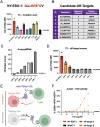This is a preprint.
De novo design and structure of a peptide-centric TCR mimic binding module
- PMID: 39763827
- PMCID: PMC11702606
- DOI: 10.1101/2024.12.16.628822
De novo design and structure of a peptide-centric TCR mimic binding module
Update in
-
De novo design and structure of a peptide-centric TCR mimic binding module.Science. 2025 Jul 24;389(6758):375-379. doi: 10.1126/science.adv3813. Epub 2025 Jul 24. Science. 2025. PMID: 40705894 Free PMC article.
Abstract
T cell receptor (TCR) mimics offer a promising platform for tumor-specific targeting of peptide-MHC in cancer immunotherapy. Here, we designed a de novo α-helical TCR mimic (TCRm) specific for the NY-ESO-1 peptide presented by HLA-A*02, achieving high on-target specificity with nanomolar affinity (Kd = 9.5 nM). The structure of the TCRm/pMHC complex at 2.05 A resolution revealed a rigid TCR-like docking mode with an unusual degree of focus on the up-facing NY-ESO-1 side chains, suggesting the potential for reduced off-target reactivity. Indeed, a structure-informed in silico screen of 14,363 HLA-A*02 peptides correctly predicted two off-target peptides, yet our TCRm maintained a wide therapeutic window as a T cell engager. These results represent a path for precision targeting of tumor antigens with peptide-focused α-helical TCR mimics.
Figures




References
-
- Rossjohn J., Gras S., Miles J. J., Turner S. J., Godfrey D. I., McCluskey J., T Cell Antigen Receptor Recognition of Antigen-Presenting Molecules. Annu. Rev. Immunol. 33, 169–200 (2015). - PubMed
-
- Cresswell P., Ackerman A. L., Giodini A., Peaper D. R., Wearsch P. A., Mechanisms of MHC class I-restricted antigen processing and cross-presentation. Immunological Reviews 207, 145–157 (2005). - PubMed
Publication types
Grants and funding
LinkOut - more resources
Full Text Sources
Research Materials
